This article relies largely or entirely on a single source .(October 2022) |

The Tatra T18 was a Czechoslovakian draisine designed and manufactured by Tatra in the 1920s.
This article relies largely or entirely on a single source .(October 2022) |

The Tatra T18 was a Czechoslovakian draisine designed and manufactured by Tatra in the 1920s.

Slovakia is a landlocked Central European country with mountainous regions in the north and flat terrain in the south. During much of the Holocene, Slovakia was much more forested than today. Decline of the forest occurred in as consequence of the Valachian colonization and the development of mining in the territory.
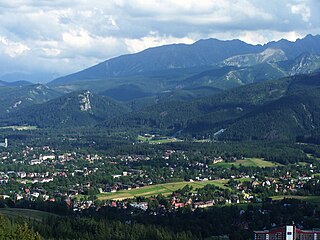
Zakopane is a town in the extreme south of Poland, in the southern part of the Podhale region at the foot of the Tatra Mountains. From 1975 to 1998, it was part of Nowy Sącz Voivodeship; since 1999, it has been part of Lesser Poland Voivodeship. As of 2017 its population was 27,266. Zakopane is a centre of Goral culture and is often referred to as "the winter capital of Poland". It is a popular destination for mountaineering, skiing, and tourism.

The Tatra Mountains, Tatras, or Tatra, is a mountain range in Central Europe that forms a natural border between Slovakia and Poland. They are the highest mountain range in the Carpathian Mountains. The Tatras are distinct from the Low Tatras, a separate Slovak mountain range further south.

Tatra is a Czech vehicle manufacturer from Kopřivnice. It is owned by the Tatra Trucks company, and it is the third oldest company in the world producing cars with an unbroken history. The company was founded in 1850 as Ignatz Schustala & Cie, in 1890 renamed in German Nesselsdorfer Wagenbau-Fabriksgesellschaft when it became a wagon and carriage manufacturer. In 1897, Tatra produced the first motor car in central Europe, the Präsident automobile. In 1918, it changed its name to Kopřivnická vozovka a.s., and in 1919 it changed from the Nesselsdorfer marque to the Tatra badge, named after the nearby Tatra Mountains on the Czechoslovak-Polish border.

Poprad is a city in northern Slovakia at the foot of the High Tatra Mountains, famous for its picturesque historic centre and as a holiday resort. It is the biggest town of the Spiš region and the tenth largest city in Slovakia, with a population of approximately 50,000.
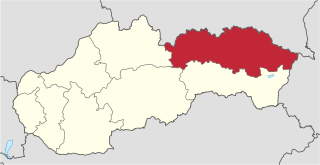
The Prešov Region, also Priashiv Region is one of the eight Slovak administrative regions and consists of 13 districts (okresy) and 666 municipalities, 23 of which have town status. The region was established in 1996 and is the most populous of all the regions in Slovakia. Its administrative center is the city of Prešov.
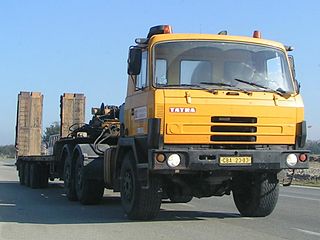
The Tatra 815 is a truck family, produced by Czech company Tatra. It uses the traditional tatra concept of rigid backbone tube and swinging half-axles giving independent suspension. The vehicles are available in 4x4, 6x6, 8x8, 10x8, 10x10, 12x8 and 12x12 variants. There are both air-cooled and liquid-cooled engines available with power ranging from 230–440 kilowatts (310–590 hp). As a successor to Tatra 813 it was originally designed for extreme off-road conditions, while nowadays there are also variants designated for mixed use. The gross weight is up to 35,500 kg (78,264 lb).

Gerlachovský štít, informally referred to as Gerlach, is the highest peak in the High Tatras, in Slovakia, and in the Carpathian Mountains. Its elevation is usually listed at 2654.4 m above mean sea level. The pyramidal shape of the massif is marked by a huge cirque. Despite its relatively low elevation, Gerlachovský štít features a vertical rise of approximately 2,000 metres (6,600 ft) above the valley floor.
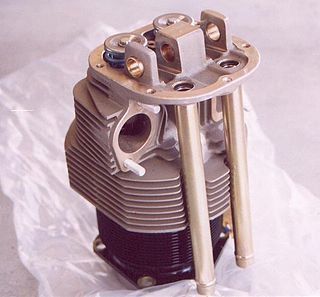
Air-cooled engines rely on the circulation of air directly over heat dissipation fins or hot areas of the engine to cool them in order to keep the engine within operating temperatures. In all combustion engines, a great percentage of the heat generated escapes through the exhaust, not through the metal fins of an air-cooled engine (12%). About 8% of the heat energy is transferred to the oil, which although primarily meant for lubrication, also plays a role in heat dissipation via a cooler. Air-cooled engines are used generally in applications which would not suit liquid cooling, as such modern air-cooled engines are used in motorcycles, general aviation aircraft, lawn mowers, generators, outboard motors, pump sets, saw benches and auxiliary power units.

Bharat Earth Movers Limited (BEML) is an Indian Public Sector Undertaking, headquartered in Bengaluru, Karnataka, India. It manufactures a variety of heavy equipment, such as that used for earth moving, transport and mining.

Tatra T6A5 is a unidirectional high-floor Czech streetcar made for public transport in Europe and is one sub-type of T6 standard trams made by Czech light rail supplier Tatra ČKD in Prague. Five cities, namely Bratislava, Košice in Slovakia and Brno, Prague and Ostrava in Czech Republic operate them in various configurations and amounts. The vehicle was designed as successor to Tatra T3 which has been operated in Europe for more than three decades at the time T6A5 was launched. The launch customer was Dopravný podnik Bratislava which received the first set of two vehicles in 1991. Brno, Bratislava, Ostrava and Košice still operate their originally ordered trams, while the fleet in Prague began retiring in 2015. They are commonly called "Irons" by general public and operator employees because their design resembles the triangular surface of clothing irons when seen from larger height.
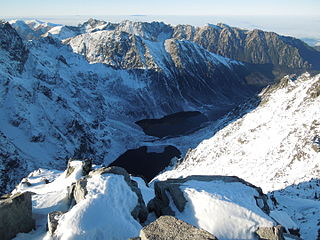
Tatra National Park is a National Park located in the Tatra Mountains in Tatra County, in the Lesser Poland Voivodeship—Małopolska region, in central-southern Poland. The Park has its headquarters in the town of Zakopane.
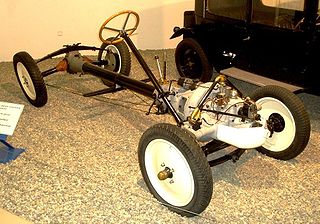
Backbone tube chassis is a type of automobile construction chassis that is similar to the body-on-frame design. Instead of a two-dimensional ladder-type structure, it consists of a strong tubular backbone that connects the front and rear suspension attachment areas. A body is then placed on this structure. It was first used in the English Rover 8hp of 1904 and then the French Simplicia automobile in 1909.

The Tatra 87 (T87) is a car built by Czechoslovak manufacturer Tatra. It was powered by a rear-mounted 2.9-litre air-cooled 90-degree overhead cam V8 engine that produced 85 horsepower and could drive the car at nearly 100 mph (160 km/h). It is ranked among the fastest production cars of its time. Competing cars in this class, however, used engines with almost twice the displacement, and with fuel consumption of 20 liters per 100 km. Thanks to its aerodynamic shape, the Tatra 87 had a consumption of just 12.5 litres per 100 km. After the war between 1950 and 1953, T87s were fitted with more-modern 2.5-litre V8 T603 engines.

The Tatra 80 is a Czechoslovak luxury full-size car built by Tatra between 1931 and 1935.

The Tatra 138 was a truck produced in Czechoslovakia by the Tatra company. The immediate successor to the Tatra 111, the model introduced a number of new features while continuing the evolution of Tatra concept. The truck was produced from 1959 to 1971.

The Tatra 75 is a Czechoslovak mid-size car that Tatra introduced in 1933 as the successor to the Tatra 54.
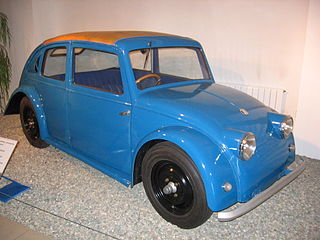
The Tatra V570 was a prototype early 1930s car developed by a team led by Hans Ledwinka and Paul Jaray. The aim of the construction team was to develop a cheap people's car with an aerodynamic body. However the company's management decided that the revolutionary ideas introduced in the prototype should be introduced in large luxurious cars, and therefore the team abandoned the project of small cars in favour of the Tatra T77, the world's first serially produced aerodynamic car. The project of a small car was later continued and led to introduction of the Tatra T97. The second V570 was built in 1933, two years before the first Volkswagen, which bears a strong resemblance to the Tatra – it was misappropriated in the opinion of Tatra, by Adolf Hitler and Dr. Ferdinand Porsche in circumstances about which the German company remains intensely sensitive.
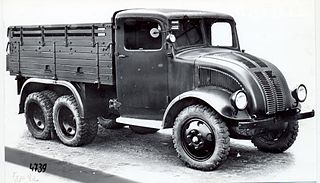
The Tatra 92 was an army off-road truck model made by Czech manufacturer Tatra between 1937 and 1941. It was mainly used for transporting military cargo and personnel in Czech and later German armies, but also ambulance and field kitchen lorry versions were made. The significant part of the production batch was exported to Kingdom of Romania.

SMS Lika was one of six Tátra-class destroyers built for the kaiserliche und königliche Kriegsmarine shortly before the First World War. Completed in August 1914, she helped to sink an Italian destroyer during the action off Vieste in May 1915 after Italy declared war on Austria-Hungary. Two months later the ship participated in an unsuccessful attempt to recapture a small island in the Central Adriatic Sea from the Italians. In November and early December Lika was one of the ships conducting raids off the Albanian coast to interdict the supply lines between Italy and Albania. The ship was sunk in Durazzo harbor during the early stages of the 1st Battle of Durazzo in late December after striking several mines.